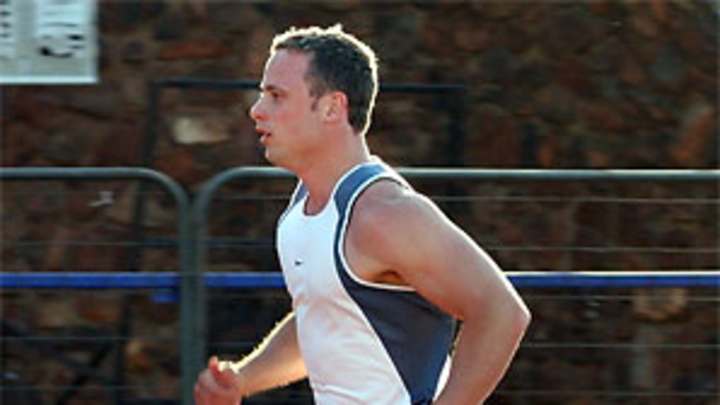Pistorius' victory is inspirational -- and controversial


If Henke and Sheila Pistorius ever unleashed upon their son, Oscar, the adage "you can grow up to be whatever you want," they might have crossed their fingers behind their backs and categorically eliminated certain professions.
Like, for example, "world class sprinter," given that Oscar was born with no fibula -- the outer bone between the knee and ankle -- in either of his legs, and had to have his legs amputated halfway between the knee and ankle before he was a year old.
And, like the rest of us, Henke and Sheila would have overlooked the spirit that has propelled Pistorius to the ranks of professional quarter milers. While the propulsion of that spirit is no longer in question -- not with Pistorius having run 46.56 in the quarter-mile, making him one of South Africa's top long sprinters -- the propulsion of the prosthetic legs Pistorius races on have been.
Pistorius, a.k.a. "the Blade Runner," races on crescent blades called "Cheetah Flex-Feet." Despite the obvious difficulty of balancing on the blades, as Pistorius continued to improve, some other sprinters questioned whether he was not disabled, but rather "too-abled."
In 2007, with the blessing of the International Association of Athletics Federation (IAAF), Pistorius competed in a Golden League meet in Rome, his first international, able-bodied event. It was a resounding triumph, as he finished second in his heat, besting seven other pros. But the way Pistorius ran the race intensified the questions -- he had already faced concerns from Paralympic competitors that his blades exaggerated what his actual leg length should be -- about the fairness of his prosthetics.
Pistorius, who is used to doing things that no man has done before, ran that 400 in Rome in virtually unheard of fashion. He was in dead last for most of the race, until about 70 meters to go, and seemed to run the second half of the race as fast or even slightly faster than the first half, gobbling up his competitors in the final strides. No other professional quarter-miler runs that way: They all blow out of the blocks and attempt to slow down as slowly as possible, but slow down they do. Inevitably, the physics of cheetah legs became a hot topic of discussion, particularly with Pistorius in line for a shot at the 2008 Olympics.
His camp contended that Oscar runs the second half of races faster because it takes him more time to get his blades up to speed, partly because unlike other sprinters who push off with their upper and lower legs and stay low coming out of the blocks, Pistorius essentially has to stand straight up out of the blocks and start generating power almost exclusively with his hips. Because his start is slow, it takes him time to get into a rhythm, they said.
To put the speculation to rest, last November, IAAF assigned Peter Brüggemann, a professor at the German Sport University, to examine Pistorius' blades. Brüggemann concluded that the spring-like blades, contrary to the contentions of some experts who study amputee athletes, returned energy more efficiently to the legs than a normal human ankle joint, allowing Oscar to coast at high speeds and expend less energy than other sprinters.
On the strength of Brüggemann's findings, Pistorius was barred from IAAF races, including the Olympics. But Pistorius appealed to the Court of Arbitration for Sport, and his legal team presented evidence from biomechanics experts suggesting that, had Brüggemann taken the entirety of Pistorius' body mechanics into account, and not just his substitute ankle joint, he would have found that Pistorius does not compete at an advantage. The court was persuaded, and unexpectedly reinstated Pistorius on Friday, after which IAAF president Lamine Diack said he will welcome Pistorius back to competition.
With his Olympic dream revived, Pistorius told the Associated Press after the ruling that he had "been struggling to hide my smile for the last half an hour." Frankly, it's hard not to smile over Pistorius. But that doesn't mean the questions will go away. Though Pistorius will have to cut about a half a second from his time to qualify individually for Beijing, he may well be picked for South Africa's 4x400-meter relay team, which, of course, means somebody who might have otherwise been an Olympian will be displaced. Sibusiso Sishi, a top South African quarter-miler, would almost certainly be picked for the relay, but is one of the small number of men who, if Pistorius lowers his time, would be looking over his shoulder.
Last year Sishi said that he doesn't "mind racing [Pistorius], but I'm still a bit skeptical about his legs because they are man made. They are carbon fiber, which means they are nice and light. I would just like him to do the tests so at least we know where we stand."
Perhaps, though, it simply isn't possible to quantify all the advantages and disadvantages that Pistorius' blades confer relative to his able-bodied counterparts. Tests have been done, and, depending who you ask, it's still not entirely clear "where we stand," on cheetah legs. What is clear is that Oscar Pistorius and his curved carbon calves have won the right to stand on the track at Beijing's National Stadium.
